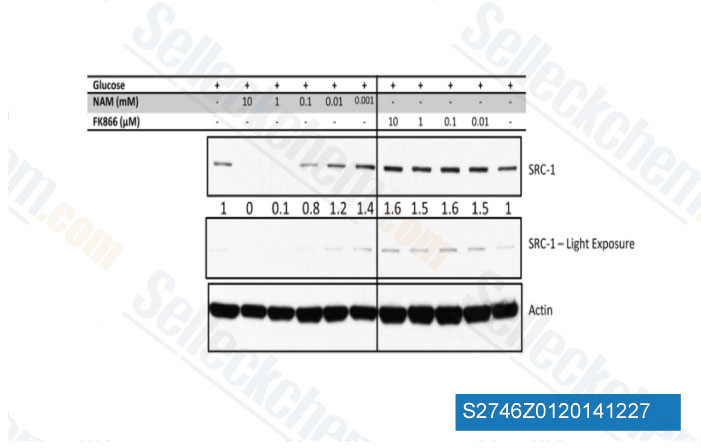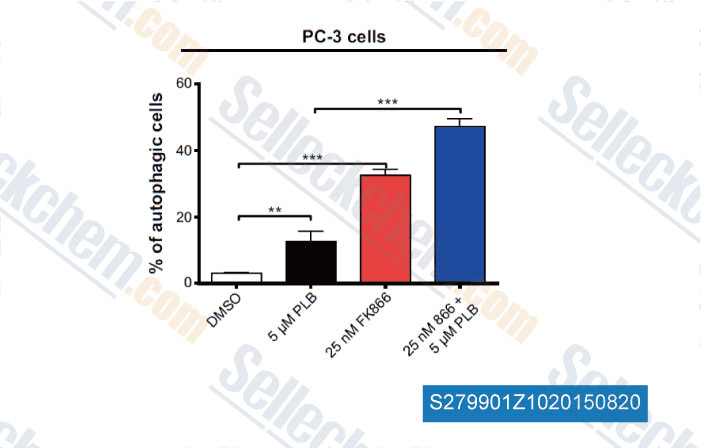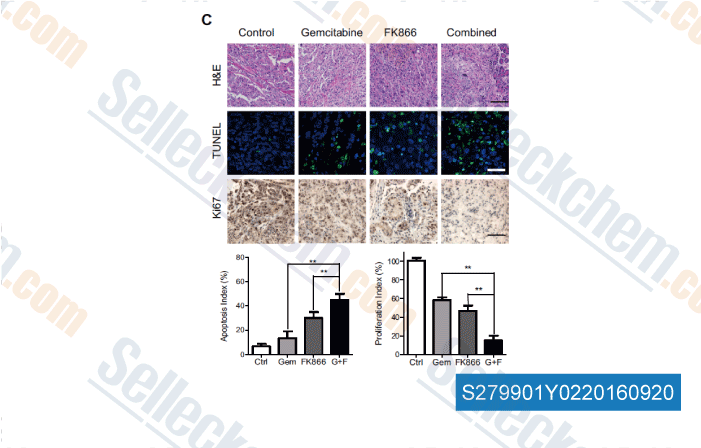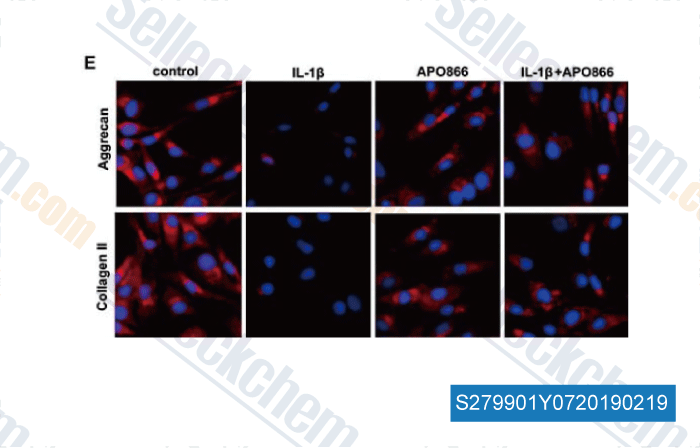|
Toll Free: (877) 796-6397 -- USA and Canada only -- |
Fax: +1-832-582-8590 Orders: +1-832-582-8158 |
Tech Support: +1-832-582-8158 Ext:3 Please provide your Order Number in the email. |
Technical Data
| Formula | C24H29N3O2 |
|||
| Molecular Weight | 391.51 | CAS No. | 658084-64-1 | |
| Solubility (25°C)* | In vitro | DMSO | 78 mg/mL (199.22 mM) | |
| Ethanol | 78 mg/mL (199.22 mM) | |||
| Water | Insoluble | |||
|
* <1 mg/ml means slightly soluble or insoluble. * Please note that Selleck tests the solubility of all compounds in-house, and the actual solubility may differ slightly from published values. This is normal and is due to slight batch-to-batch variations. * Room temperature shipping (Stability testing shows this product can be shipped without any cooling measures.) |
||||
Preparing Stock Solutions
Biological Activity
| Description | Daporinad (FK866) effectively inhibits nicotinamide phosphoribosyltransferase (NMPRTase; Nampt) with IC50 of 0.09 nM in a cell-free assay. Daporinad (FK866, APO866) triggers autophagy. Phase 1/2. | ||
|---|---|---|---|
| Targets |
|
||
| In vitro | APO866 at low concentrations ranging from 0.09-27 nM induces dose-dependent cytotoxicity in 41 hematologic malignant cells including acute myeloid leukemia [AML], acute lymphoblastic leukemia [ALL], mantle cell lymphoma [MCL], chronic lymphocytic leukemia [CLL], and T-cell lymphoma. APO866 at low concentrations ranging from 0-10 nM induces cell death, this effect is independent of caspase activation but is associated with depolarization of mitochondrial membrane. APO866 at concentrations ranging from 0-10 nM dose-dependently induces depletion of intracellular NAD and ATP contents and cell death in various hematologic cancer cells. [1] APO866 at concentration of 10 nM inhibits PBEF-induced secretion of MMP-3, CCL2, and CXCL8 in HFFF2 cells. [2] | ||
| In vivo | APO866 administered intraperitoneally at dose of 20 mg/kg twice a day for 4 days, repeat weekly over 3 weeks, prevents and abrogats tumor growth in C.B.-17 SCID mice xenograft models of human AML, lymphoblastic lymphoma, and leukemia. [1] APO866 at dose of 0.12 mg/kg/hour prevents joint destruction and leukocyte infiltration through inhibition of PBEF in mice with CIA. [2] |
Protocol (from reference)
| Cell Assay: |
|
|---|---|
| Animal Study: |
|
References
Customer Product Validation

-
Data from [Data independently produced by Mol Endocrinol, 2014, 28(3), 395-405]

-
Data from [Data independently produced by , , Drug Des Devel Ther, 2015, 9: 1511-54]

-
Data from [Data independently produced by , , Cancer Lett, 2016, 379(1):1-11.]

-
Data from [Data independently produced by , , Cell Physiol Biochem, 2018, 49(6):2463-2482]
Selleck's Daporinad (FK866) has been cited by 65 publications
| Integration of 3D bioprinting and multi-algorithm machine learning identified glioma susceptibilities and microenvironment characteristics [ Cell Discov, 2024, 10(1):39] | PubMed: 38594259 |
| Decreased liver B vitamin-related enzymes as a metabolic hallmark of cancer cachexia [ Nat Commun, 2023, 14(1):6246] | PubMed: 37803016 |
| Decreased liver B vitamin-related enzymes as a metabolic hallmark of cancer cachexia [ Nat Commun, 2023, 14(1):6246] | PubMed: 37803016 |
| NAD+ Metabolism Generates a Metabolic Vulnerability in Endocrine-Resistant Metastatic Breast Tumors in Females [ Endocrinology, 2023, 164(6)bqad073] | PubMed: 37170651 |
| Improving lysosomal ferroptosis with NMN administration protects against heart failure [ Life Sci Alliance, 2023, 6(12)e202302116] | PubMed: 37793777 |
| Improving lysosomal ferroptosis with NMN administration protects against heart failure [ Life Sci Alliance, 2023, 6(12)e202302116] | PubMed: 37793777 |
| DePARylation is critical for S phase progression and cell survival [ bioRxiv, 2023, 2023.07.31.551317] | PubMed: 37577639 |
| DePARylation is critical for S phase progression and cell survival [ bioRxiv, 2023, 2023.07.31.551317] | PubMed: 37577639 |
| Discovery of small-molecule activators of nicotinamide phosphoribosyltransferase (NAMPT) and their preclinical neuroprotective activity [ Cell Res, 2022, 10.1038/s41422-022-00651-9] | PubMed: 35459935 |
| secDrug: a pipeline to discover novel drug combinations to kill drug-resistant multiple myeloma cells using a greedy set cover algorithm and single-cell multi-omics [ Blood Cancer J, 2022, 12(3):39] | PubMed: 35264575 |
RETURN POLICY
Selleck Chemical’s Unconditional Return Policy ensures a smooth online shopping experience for our customers. If you are in any way unsatisfied with your purchase, you may return any item(s) within 7 days of receiving it. In the event of product quality issues, either protocol related or product related problems, you may return any item(s) within 365 days from the original purchase date. Please follow the instructions below when returning products.
SHIPPING AND STORAGE
Selleck products are transported at room temperature. If you receive the product at room temperature, please rest assured, the Selleck Quality Inspection Department has conducted experiments to verify that the normal temperature placement of one month will not affect the biological activity of powder products. After collecting, please store the product according to the requirements described in the datasheet. Most Selleck products are stable under the recommended conditions.
NOT FOR HUMAN, VETERINARY DIAGNOSTIC OR THERAPEUTIC USE.
